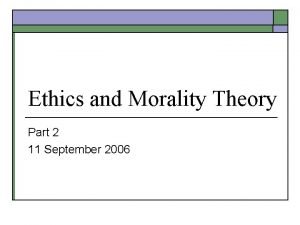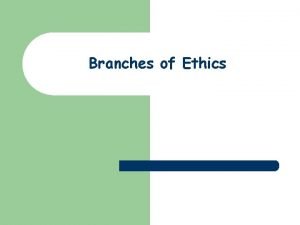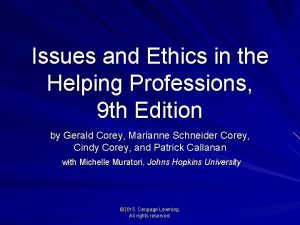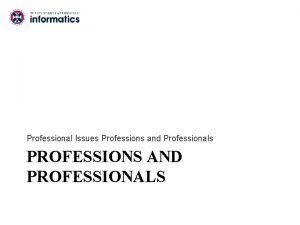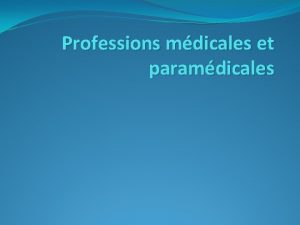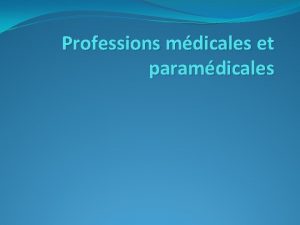Issues and Ethics in the Helping Professions 9







































- Slides: 39

Issues and Ethics in the Helping Professions, 9 th Edition by Gerald Corey, Marianne Schneider Corey, Cindy Corey, and Patrick Callanan with Michelle Muratori, Johns Hopkins University © 2015. Cengage Learning. All rights reserved.

Chapter 6 CONFIDENTIALITY: ETHICAL AND LEGAL ISSUES © 2015. Cengage Learning. All rights reserved.

Confidentiality and Related Terms Confidentiality: – Rooted in a client’s right to privacy, confidentiality is at the core of effective therapy – It is the counselor’s ethical duty to protect private client communication © 2015. Cengage Learning. All rights reserved.

Confidentiality and Related Terms Privileged communication: – A legal concept that generally bars the disclosure of confidential communications in a legal proceeding – Specifics of this privilege vary from state to state Privacy: – The constitutional right of individuals to be left alone and to control their personal information © 2015. Cengage Learning. All rights reserved.

Protecting Confidentiality Rights Fisher’s (2008) 6 -step ethical practice model for protecting confidentiality rights: 1. Preparation 2. Tell clients the truth “up front” 3. Obtain truly informed consent before making a disclosure © 2015. Cengage Learning. All rights reserved.

Protecting Confidentiality Rights Fisher’s (2008) 6 -step ethical practice model for protecting confidentiality rights: 4. Respond ethically to legal requests for disclosure 5. Avoid the “avoidable” breaches of confidentiality 6. Talk about confidentiality © 2015. Cengage Learning. All rights reserved.

Limits of Confidentiality When clerical assistants handle confidential information When a counselor consults When a counselor is being supervised When a client has given consent When a client poses danger to self or others © 2015. Cengage Learning. All rights reserved.

Limits of Confidentiality When a client discloses intention to commit a crime When a counselor suspects abuse or neglect of a child or vulnerable adult When a court orders counselor to make records available © 2015. Cengage Learning. All rights reserved.

Privacy Issues With Telecommunication Devices Do not acknowledge that clients are receiving services or give out information regarding clients to unknown callers. Strive to verify that you are actually talking to the intended person when you make or receive calls in which confidential information will be discussed. © 2015. Cengage Learning. All rights reserved.

Privacy Issues With Telecommunication Devices Be aware that there is no way to prevent your conversation from being recorded or monitored by an unintended person. Avoid making any comments you would not want your client to hear or you would not want to repeat in a legal proceeding. © 2015. Cengage Learning. All rights reserved.

Privacy Issues With Telecommunication Devices Be professional and cautious in talking about confidential information over the telephone. Avoid saying anything off the record. Do not allow unauthorized persons to hear answering machine messages in your office as they are being left or retrieved. © 2015. Cengage Learning. All rights reserved.

Privacy Issues With Telecommunication Devices If you are talking to a client by cellular phone, assume that he or she is not in a private place. Realize that your conversation may be intercepted by an unauthorized person. If you use voicemail or an answering service, ensure your access codes are not disclosed to unauthorized persons. © 2015. Cengage Learning. All rights reserved.

Privacy Issues With Telecommunication Devices If you use a pager or cell phone to send text messages, exercise caution. – In sending a text message to a client, be mindful of ensuring your client’s privacy by exercising the same caution you would if you were sending a voicemail message. © 2015. Cengage Learning. All rights reserved.

Privacy Issues With Telecommunication Devices When you leave a message on an answering machine, be aware that the intended person may not be the one who retrieves your message. © 2015. Cengage Learning. All rights reserved.

Implications of HIPAA for Mental Health Providers The Health Insurance Portability and Accountability Act of 1996 (HIPAA) – Promote standardization and efficiency in the health care industry and give patients more rights/control over their health information. – HIPAA Privacy Rule developed out of concern that transmission of health care information through electronic means could lead to wide gaps in protection of client confidentiality. © 2015. Cengage Learning. All rights reserved.

Implications of HIPAA for Mental Health Providers If you submit a claim electronically, even once, you are likely to be considered a “covered entity” for HIPAA purposes. Be familiar with the 4 standards of HIPAA: 1. 2. 3. 4. Privacy requirements Electronic transactions Security requirements National identifier requirements © 2015. Cengage Learning. All rights reserved.

Duty to Protect Potential Victims Balancing client confidentiality and protecting the public is a major ethical challenge. © 2015. Cengage Learning. All rights reserved.

Duty to Protect Potential Victims Counselors must exercise the ordinary skill and care of a reasonable professional to: – Identify clients who are likely to do physical harm to third parties – Protect third parties from clients judged potentially to be dangerous – Treat those clients who are dangerous © 2015. Cengage Learning. All rights reserved.

Liability for Civil Damages The responsibility to protect the public from dangerous acts of violent clients entails liability for civil damages when practitioners neglect this duty by: Failing to diagnose or predict dangerousness © 2015. Cengage Learning. All rights reserved.

Liability for Civil Damages Failing to warn potential victims of violent behavior Failing to commit dangerous individuals Prematurely discharging dangerous clients from a hospital © 2015. Cengage Learning. All rights reserved.

Legal Precedents Tarasoff Case – Duty to warn of harm to self or others – Duty to protect Bradley Case – Duty not to negligently release a dangerous client Jablonski Case – Duty to commit a dangerous individual © 2015. Cengage Learning. All rights reserved.

Legal Precedents Hedlund Case – Extends duty to warn to anyone who might be near the intended victim and who might also be in danger Jaffee Case – Communications between licensed psychotherapists and their clients are privileged and therefore protected from forced disclosure in cases arising under federal law © 2015. Cengage Learning. All rights reserved.

Risk Management Guidelines In cases involving the duty to warn and protect: – Consult with an attorney if you are not clear about your legal duty as well as with colleagues or a supervisor. – Know the relevant laws in your state. – Inquire about a client’s access to weapons, homicidal ideation, and intentions, including whether a specific victim is involved. © 2015. Cengage Learning. All rights reserved.

Risk Management Guidelines In cases involving the duty to warn and protect: – Consider all appropriate steps to take and their consequences. – Obtain prior medical and behavioral history. – Know and follow the policy of your institution. – In cases of immediate threat by a client, do not hesitate to take steps to prevent harm to yourself. © 2015. Cengage Learning. All rights reserved.

Risk Management Guidelines In cases involving the duty to warn and protect: – Document all actions you take and the rationale behind each of your decisions. – Make referrals where appropriate. © 2015. Cengage Learning. All rights reserved.

School Counselor Liability for Student Suicide Counselors need to educate school employees (especially teachers) about the risk factors associated with adolescent suicide. Counselors might institute peer assistance programs to help identify students at risk for suicide. © 2015. Cengage Learning. All rights reserved.

School Counselor Liability for Student Suicide It would be useful for school counselors to have increased access to training programs geared toward acquiring information about student suicide. In cases where school counselors make an assessment that a student is at risk for suicide, it is imperative that the student’s parents or guardians be notified. © 2015. Cengage Learning. All rights reserved.

School Counselor Liability for Student Suicide One of the first cases that addressed school counselor liability for student suicide was Eisel v. Board of Education (1991). School counselors would do well to take the initiative in obtaining continuing education on recent developments in the field of student suicide to help limit their legal liability. © 2015. Cengage Learning. All rights reserved.

Guidelines for Assessing Suicidal Behavior Take direct verbal warnings seriously. Pay attention to previous suicide attempts. Identify clients suffering from depression. Be alert for feelings of hopelessness and helplessness. Monitor severe anxiety and panic attacks. Explore the interpersonal stressor of loss and separation. © 2015. Cengage Learning. All rights reserved.

Guidelines for Assessing Suicidal Behavior Ascertain whethere has been a recent diagnosis of a serious or terminal health condition. Ascertain whethere has been any suicide in the family. Assess the client’s support system. – If there is no support system, the client is at greater risk. © 2015. Cengage Learning. All rights reserved.

Guidelines for Assessing Suicidal Behavior Determine whether the client has a plan. Identify clients who have a history of severe alcohol or drug abuse. Be alert to client behaviors (e. g. giving prized possessions away, finalizing business affairs, or revising wills). Determine the history of psychiatric treatment. © 2015. Cengage Learning. All rights reserved.

Protecting Children, Elderly, and Dependent Adults from Harm Mandatory reporting is designed to encourage reporting of any suspected cases of child, elder, or dependent adult abuse. If children, the elderly, or other dependent adults disclose that they are being abused or neglected, the professional is required to report the situation under penalty of fines and imprisonment. © 2015. Cengage Learning. All rights reserved.

Protecting Children, Elderly, and Dependent Adults from Harm The professional has an obligation to protect those who cannot advocate for themselves. © 2015. Cengage Learning. All rights reserved.

Types of Elder Abuse Physical abuse Sexual abuse Psychological or emotional abuse Neglect Abandonment Financial or material exploitation © 2015. Cengage Learning. All rights reserved.

Disclosure of a Client’s HIV Status The law is not clear pertaining to the duty to protect in cases pertaining to HIV status. It is extremely important to know the specific law in your jurisdiction and to seek consultation from a colleague experienced with reporting requirements. © 2015. Cengage Learning. All rights reserved.

Disclosure of a Client’s HIV Status From a legal perspective, breaching confidentiality because of a client’s HIV status is not one of the exceptions to confidentiality. © 2015. Cengage Learning. All rights reserved.

Recommendations for Counseling HIV-Positive Clients All limits to confidentiality should be discussed at the outset of treatment. Therapists must be aware of state laws regarding their professional interactions with HIV-positive clients. Therapists need to keep current with relevant medical information, including which sexual practices are safer. © 2015. Cengage Learning. All rights reserved.

Recommendations for Counseling HIV-Positive Clients Therapists should speak directly and openly with their clients about their concerns regarding the danger of certain behaviors and the risk to third parties. If the client continues to resist using safer sex practices or refuses to inform partners, then therapist needs to determine what course of action to follow. © 2015. Cengage Learning. All rights reserved.

Recommendations for Counseling HIV-Positive Clients In disclosing HIV information, therapists need to follow the statutory guidelines and safeguard the client’s privacy as much as possible. © 2015. Cengage Learning. All rights reserved.
 Issues and ethics in the helping professions 9th edition
Issues and ethics in the helping professions 9th edition Issues and ethics in the helping profession
Issues and ethics in the helping profession All 23 linking verbs
All 23 linking verbs Jobs and occupations reading comprehension
Jobs and occupations reading comprehension Visual sketchpad memory
Visual sketchpad memory A historian of physical activity would look at
A historian of physical activity would look at Shortterm
Shortterm Wickens et al fruit meat and professions
Wickens et al fruit meat and professions Engineering and geoscience professions act
Engineering and geoscience professions act State legal ethical and professional aspects of security
State legal ethical and professional aspects of security Macro and micro ethics
Macro and micro ethics Environmental ethics issues and possible solutions
Environmental ethics issues and possible solutions Most dangerous professions
Most dangerous professions Allied medical professions list
Allied medical professions list New global professions
New global professions Listening professions
Listening professions Professions english lesson
Professions english lesson Fitness professions
Fitness professions Classification internationale type des professions
Classification internationale type des professions William shakespeare professions
William shakespeare professions In your notebook write sentences to answer the questions
In your notebook write sentences to answer the questions South african council for natural scientific professions
South african council for natural scientific professions Agriscience careers
Agriscience careers Factual vs conceptual
Factual vs conceptual Environmental ethics issues
Environmental ethics issues Nike ethical issue
Nike ethical issue Descriptive ethics
Descriptive ethics Normative ethics
Normative ethics Aspects of honesty
Aspects of honesty Metaethics vs normative ethics
Metaethics vs normative ethics Descriptive ethics vs normative ethics
Descriptive ethics vs normative ethics Discipline
Discipline Metaethics vs normative ethics
Metaethics vs normative ethics Descriptive ethics vs normative ethics
Descriptive ethics vs normative ethics What is deontological ethics
What is deontological ethics Teleological ethics vs deontological ethics
Teleological ethics vs deontological ethics Hình ảnh bộ gõ cơ thể búng tay
Hình ảnh bộ gõ cơ thể búng tay Lp html
Lp html Bổ thể
Bổ thể Tỉ lệ cơ thể trẻ em
Tỉ lệ cơ thể trẻ em






























